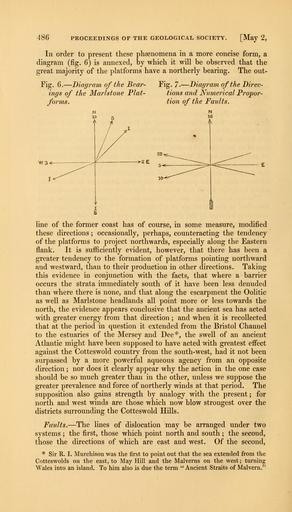MAKE A MEME
View Large Image

| View Original: | The_Quarterly_journal_of_the_Geological_Society_of_London_(12711575645).jpg (1828x3200) | |||
| Download: | Original | Medium | Small | Thumb |
| Courtesy of: | commons.wikimedia.org | More Like This | ||
| Keywords: The Quarterly journal of the Geological Society of London (12711575645).jpg 486 PROCEEDINGS OF THE GEOLOGICAL SOCIETY May 2 <br> In order to present these phsenomena in a more concise form a <br> diagram fig 6 is annexed by which it will be observed that the <br> great majority of the platforms have a northerly bearing The out- <br> Fig 6 ” Diagram of the Bear- <br> ings of the Marlstone Plat- <br> forms <br> Fig 7 ” Diagram of the Direc- <br> tions and Numerical Propor- <br> tion of the Faults <br> Vi/3 <br> 2E <br> line of the former coast has of course in some measure modified <br> these directions ; occasionally perhaps counteracting the tendency <br> of the platforms to project northwards especially along the Eastern <br> flank It is sufficiently evident however that there has been a <br> greater tendency to the formation of platforms pointing northward <br> and westward than to their production in other directions Taking <br> this evidence in conjunction with the facts that where a barrier <br> occurs the strata immediately south of it have been less denuded <br> than where there is none and that along the escarpment the Oolitic <br> as well as Marlstone headlands all point more or less towards the <br> north the evidence appears conclusive that the ancient sea has acted <br> vdth greater energy from that direction ; and when it is recollected <br> that at the period in question it extended from the Bristol Channel <br> to the estuaries of the Mersey and Dee the swell of an ancient <br> Atlantic might have been supposed to have acted with greatest effect <br> against the Cotteswold country from the south-west had it not been <br> surpassed by a more powerful aqueous agency from an opposite <br> direction ; nor does it clearly appear why the action in the one case <br> should be so much greater than in the other unless we suppose the <br> greater prevalence and force of northerly winds at that period The <br> supposition also gains strength by analogy with the present ; for <br> north and west winds are those which now blow strongest over the <br> districts surrounding the Cotteswold Hills <br> Faults ” The lines of dislocation may be arranged under two <br> systems ; the first those which point north and south ; the second <br> those the directions of which are east and west Of the second <br> Sir R I Murchison was the first to point out that the sea extended from the <br> Cotteswolds on the east to May Hill and the Malverns on the west ; turning <br> Wales into an island To him also is due the term Ancient Straits of Malvern 35615088 110213 51125 Page 486 Text v 11 http //www biodiversitylibrary org/page/35615088 1855 Geological Society of London Biodiversity Heritage Library The Quarterly journal of the Geological Society of London v 11 1855 Geology Periodicals Smithsonian Libraries bhl page 35615088 dc identifier http //biodiversitylibrary org/page/35615088 smithsonian libraries Information field Flickr posted date ISOdate 2014-02-23 Check categories 2015 August 26 CC-BY-2 0 BioDivLibrary https //flickr com/photos/61021753 N02/12711575645 2015-08-26 20 53 40 cc-by-2 0 PD-old-70-1923 The Quarterly journal of the Geological Society of London 1855 Photos uploaded from Flickr by Fæ using a script | ||||